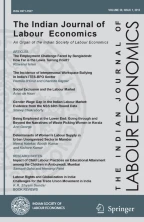
Historical experience suggests that a sustained rise in per capita incomes and improvement in employment conditions is not attainable without a structural transformation that moves surplus labour from agriculture and other informal economic activities to higher productivity activities in the non-farm economy. In this paper, I analyse India’s performance from a cross-country comparative perspective, estimating the growth semi-elasticity of structural change. Using a cross-country panel regression, I estimate the effectiveness of growth in moving workers away from agricultural and informal activities as compared to other developing countries at similar levels of per capita income. I show that the performance in pulling workers out of agriculture is as expected given its level and growth of GDP per capita, but the same is not true for pulling workers out of the informal sector. I also propose the following five indicators that need to be kept track of when evaluating the growth process: the growth elasticity of employment, the growth semi-elasticity of structural change, the growth of labour productivity in the subsistence sector, the share of the organised sector in total employment and the workforce participation rate. Comparing these indicators across periods, states, regions or countries, allows us to understand which sets of policies have worked better than others to effective improvements in employment conditions. And taken together the indicators allow us to set structural change targets as well as to say whether the current pattern of growth is going to be sufficient to meet those targets.
Avoid common mistakes on your manuscript.
The COVID-19 pandemic has devastated livelihoods across the world on a massive scale. India is no exception. Even prior to the pandemic, the inability of the Indian economy to create an adequate number of good, non-farm jobs was a topic of much debate in academic as well as popular realms; though at times this debate has generated more heat than light due to its political implications. In the years leading up to the pandemic, not only had economic growth slowed down, but the relationship between growth and jobs was the weakest it had ever been. In the aftermath of the COVID-19 crisis, the employment challenge has acquired even more urgency. It is too early to predict the long-term consequences of the pandemic-induced shock on India’s structural transformation trajectory. Hence, the present paper deals mainly with legacy problems of weak structural transformation and slow employment generation that are expected to continue, if not worsen in the years to come.
The Indian economy is characterised by declining output elasticity of employment generation, increasing informalisation within the organised sector, and a weak tendency towards structural transformation arising from a mismatch between high-growth and high labour absorption sectors together with serious constraints on the supply-side of the labour market, such as persistently low rates of labour force participation by women and a skilling/education crisis. Footnote 1 Thus, the labour market suffers from structural problems on both the demand and the supply side. The results are persistently high levels of informality and underemployment, as well as high levels of open unemployment among educated youth.
The resulting debates on jobless growth, low female labour force participation, and continued informality have yielded rich insights into the Indian experience. However, there is sometimes a lack of clarity on what indicators to look at and what the appropriate points of comparison are. The result is confusion with regard to the pace and nature of structural transformation. In this paper, I propose a set of indicators that draw on existing literature and together can present a comprehensive picture of structural change. In these indicators, special emphasis is placed on employment conditions as opposed to output growth rates.
I also analyse the nature of India’s structural transformation in a global perspective using the World Development Indicators database (WDI) and the Economic Transformation Database (ETD) of the Growth and Development Centre of the University of Groningen. Country-level data for India are obtained from the Employment-Unemployment Survey and the Periodic Labour Force Surveys of the NSO.
I show that India’s performance in pulling workers out of agriculture is as expected given its level of GDP per capita, but the same is not true for pulling workers out of the informal sector as a whole. The result is a vicious cycle that connects precarity in the labour market to lack of structural change via a worsening distribution of income. I offer a conceptual framework to understand slow structural change and persistence of informality in India. I conclude by drawing on recent policy work at the Centre for Sustainable Employment and elsewhere to present a possible framework for a national employment policy that addresses both supply and demand side problems in the labour market.
The paper is organised as follows. Section 2 outlines 5 key indicators that capture the relationship between growth, structural change and employment and that can be used to gauge the extent and nature of structural change. Section 3 takes a closer look at India’s performance over the past decade. Section 4 places India’s trajectory over the past three decades in an international perspective. Section 5 outlines a conceptual model to explain slow structural change. Section 6 offers a possible framework for a national employment policy.
Historical experiences of both early and late industrialising economies suggest that a sustained rise in per capita incomes and improvement in working conditions for the vast majority of workers have not been attainable without structural transformation that moves surplus labour from agriculture and other informal economic activities to higher productivity activities in the non-farm economy, particularly the manufacturing sector. Footnote 2 A successful structural transformation increases aggregate labour productivity and eliminates surplus labour, thereby increasing the bargaining power of workers, raising labour share of income and improving working conditions. Further, in a global context, the existence of surplus labour in one economy weakens the bargaining position of workers in other (even non-labour surplus) economies. Thus successful structural transitions in large labour surplus economies such as India can improve conditions for workers all over the world.
The relationship between economic growth and structural change can be thought of as being composed of three inter-related but distinct processes which may be labelled as the Solow Process, the Kuznets Process and the Lewis Process. The first refers to within-sector growth in labour productivity as a result of capital accumulation and technical change. The second refers to the transfer of labour from agriculture to higher-value added activities in the non-farm economy, initially to manufacturing and then to services. The third refers to the transfer of labour from subsistence-oriented activity to profit-oriented activity. While the second and the third have often been treated synonymously, they are analytically distinct in the sense that one can occur without the other. As I show later, this is the case for India.
The three processes can be mutually reinforcing resulting in a virtuous cycle of structural transformation and rapid growth. This happens when labour productivity rises within both the modern or capitalist and the subsistence or non-capitalist sectors, resulting in a broad-based increase in incomes and demand for manufactured goods and services as well as favourable terms of trade for the industrial sector. If growth in the modern sector is not offset by falling employment intensity, the result is increasing derived demand for labour in this sector. This in turn promotes the Kuznets as well as Lewis processes, thereby further raising productivity due to a reallocation of labour towards higher productivity activities. Footnote 3
But there is also the possibility of a low-level equilibrium or a vicious cycle. If growth is limited to the modern sector only, and further is of the kind that demands factor inputs in the “wrong” proportions, not in keeping with relative factor endowments (e.g. by becoming more capital intensive), it does not result in structural transformation. This further means that gains in productivity due to reallocation of labour do not come about. Majority of workers remain in low-productivity activities, income grows much more slowly or not at all, for the majority, and demand remains narrowly concentrated. This dampens industrial sector growth and surplus labour persists, putting downward pressure on wages and working conditions for the entire workforce. Footnote 4
Thus we can propose the following conditions: growth is a necessary but not sufficient condition for structural change. That is growth creates the possibility of increased demand for labour in the modern sector, but if it is accompanied by falling employment intensity, it fails to deliver structural change. Structural change is a sufficient but not necessary condition for growth. That is, a relocation of labour from low to high productivity sectors increases average labour productivity (and thus causes growth), but increases in labour productivity can be had without such a reallocation (e.g. via technical change). Most crucially, from a welfare standpoint (which is the primary goal of economic policy), both structural change and growth are necessary for improvement in working conditions—neither by itself is sufficient. It follows from the three conditions above that the central concern of policy-making should be structural change and not growth.
Ghose (2006) points to the key conditions that must be met in order for growth to result in an improvement in employment conditions. First, output growth in the modern sector must be such that the resulting employment growth exceeds the growth of the labour force. And second, per person output or productivity in the traditional sector must at least remain constant (if it does not increase). Ghose makes the crucial point that if growth policy remains focused only on the modern sector, it is likely to fail in improving employment conditions. But a growth strategy that encompasses the subsistence sector can do so. Taking cue from the two key relationships mentioned above from Ghose, we can define five key indicators that allow us to measure the effectiveness of growth in creating employment as well as the pace of structural transformation.
The first is the ratio of aggregate employment growth to aggregate output growth or the growth elasticity of employment. The second is the change in share of the workforce employed in agriculture and in the informal sector with respect to GDP growth. This can be termed the growth semi-elasticity of structural change. The third indicator is the ratio of output growth in the subsistence sector to the growth rate of the workforce or the growth of labour productivity in the subsistence sector. The fourth is the ratio of organised sector or formal sector employment growth to the growth rate of the workforce (i.e. the share of the organised sector in total employment). Finally, in the case of India, where workforce participation rates have been stagnant or falling, especially for women, we also need to look at the ratio of workforce growth to working age population growth.
The first indicator tells us the effectiveness of growth in creating employment in general. The second tells us how effective growth is in facilitating the Kuznets or Lewis processes. The third tells us whether productivity (and hence incomes) are rising or at least not falling in the subsistence sector. The fourth (often expressed as the share of the organised sector in the workforce) must be rising for structural change to be proceeding. The fifth tells us whether employment (of the formal or informal kind) is being generated in adequate amounts to meet the growing population.
Note that none of the above is adequate in and of itself. A large employment elasticity may be the result of informal job creation, a rise in the share of the organised sector may come at the cost of overall employment, a rise in the WPR, if accompanied by falling per person output in the subsistence sector, indicates distress and not improvement in labour conditions. Ideally, economic policy should bring about output growth that results in a growth rate of employment such that the WPR is stable or increasing, productivity in the subsistence sector is constant or rising, shares of agriculture and the subsistence sector in employment are falling, and the share of the organised sector in total employment is increasing.
Comparing these indicators across periods (e.g. pre- or post-reform), states, regions or countries, allows us to understand which sets of policies have worked better than others. And taken together the indicators allow us to set structural change targets as well as to say whether the current pattern of growth is going to be sufficient to meet those targets.
The growth elasticity of employment (sometimes called just “employment elasticity”) has received a lot of attention in the debate over jobless growth. As is well known, it has been steadily falling in India over the past few decades (Misra and Suresh 2014; Papola and Sahu 2012; State of Working India 2018). The current stylised fact is that it is around 0.1, i.e. a 10% GDP growth rate is associated with a 1% rise in employment. This is partly due to the fact that the sectors that have driven growth (such as finance and IT-BPO) are not large employers, and large employers (with the exception of construction) have not shown rapid output growth (e.g. informal retail, textiles, transport). Footnote 5
Though the elasticity numbers are helpful when compared across countries or over time, to characterise the growth process, they need to be interpreted with caution, as I argue later. A more useful benchmark regarding whether aggregate employment generation is adequate, is to compared it to the growth of the working age population. A very low employment elasticity suggests that the growth in the workforce may not have kept pace with the growth rate of the working age population. Note that if the two are equal, the workforce participation rate is stable, if employment generation is faster, the WPR increases, else it falls.
Here it must be borne in mind that the conventional definition of “working age” starts at 15 years of age. But rising education levels mean individuals tend to enter the labour force later. Thus, as average education levels rise, the growth of the potential workforce slows down because of a rise in the proportion of youth (aged 15 to 25 years), who stay on in education instead of looking for work. Nath and Basole (2021) account for this by focusing only on the population aged 25 years and above. Strikingly, they find that even in this group, growth of employment has lagged behind growth of the population.
They emphasise two points with respect to the employment trends between 2011–2012 and 2017–2018. First, for men, employment rose but the pace fell short of what was required given the rise in the (25 +) working age population resulting in a fall in the workforce participation rate. Second, employment fell in absolute terms, in subsidiary economic activities in agriculture pursued by older rural women. This fall in female agricultural employment is part of an overall decline in employment in this sector, from 232 million (49% of the workforce) to 205 million (44% of the workforce). While a decline in agricultural employment is to be expected and also welcome from a structural transformation perspective, more worrying is the fact that manufacturing employment also fell in this period by 3.5 million, reducing an already low share in total workforce from 12.6 to 12.1% (Mehrotra and Parida 2019).
Between 2017–2018 and 2018–2019, the total workforce grew by 13 million, making up for employment lost between 2011–2012 and 2017–2018. While the working age population grew by 1.8%, the labour force grew by 2.7% and the workforce by 2.95%. As a result, the LFPR as well as the WPR rose and the unemployment rate fell (State of Working India 2021). Although the WPR has been rising since 2017–2018, as of 2019–2020 it had not reached the 2011–2012 level. Further, as has been widely debated in recent years, the female LFPR remains stubbornly low.
Coming back to the growth elasticity of employment, because of the fall in aggregate employment in the first half of the past decade (Kannan and Raveendran 2019; Nath and Basole 2021), between 2011–2012 and 2018–2019, while GDP grew at a CAGR of 6.67%, the total increase in the workforce was only 0.26%, yielding an incredibly low elasticity of 0.04. In other words, at this rate of employment generation, a doubling of GDP would only increase employment by 4%. But this may be an anomalous situation because the absolute decline in employment seems to have been a one-time phenomenon and has reversed itself.
Just as the elasticity numbers in and of themselves are hard to interpret, without reference to the growth of the working age population, the rise in the WPR cannot unproblematically be interpreted as a good thing. One also needs to look at what is happening to incomes in the subsistence sector. This is illustrated by the familiar problem of low/declining female labour participation in India. Figure 1 shows the cross-country relationship between GDP per capita and the female labour force participation rate. Despite the large amount of noise, the well-known U-shaped relationship is visible. India is clearly an outlier on the low side. Thus it is understandable that much emphasis has been placed on raising female labour force participation. But it should be underlined that it is not enough to raise the supply of women’s labour without raising the demand for it as well. In the absence of higher labour demand, an increased supply would only serve to lower earnings as women crowd into the subsistence sector.
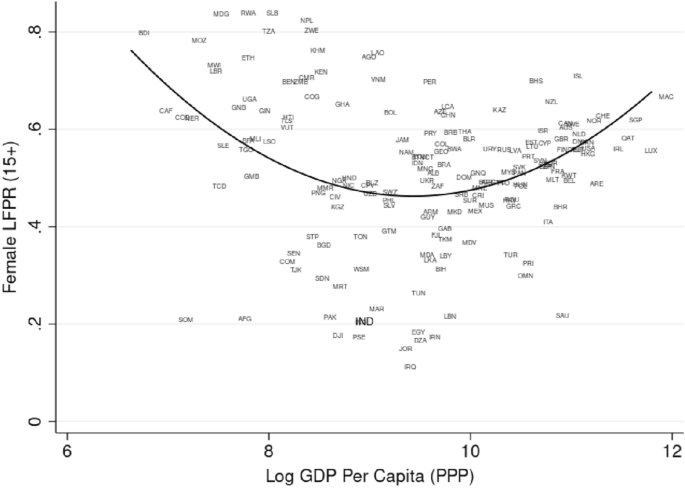
This is where indicator 3 above becomes relevant. What we would like to see is an increase in the WPR alongside constant or increasing productivity or earnings in the subsistence sector. As mentioned earlier, the WPR increased for rural and urban women between 2017–2018 and 2018–2019. However, earnings from self-employment for women increased in nominal terms by only 2.3% (as opposed to 5.2% for men) in rural areas and actually declined in nominal terms by 5.5% (while they increased by 4.1% for men) in urban areas. Since rural inflation in this period was 3% while urban inflation was 4%, it is clear that in real terms women’s earnings from self-employment fell at the time when their labour force participation rose. This points to distress-led participation on part of women.
Thus, while preventing a decline in the WPR (setting aside educational enrollment as noted) could be a policy goal, merely increasing the WPR cannot be one. It is the nature of employment generated that matters. For this, we need to look at the shares of non-farm as well as formal or organised sector employment. Table 1 shows the share of the workforce in 2011–2012 and 2018–2019 that was engaged in enterprises having 10 or more workers (% organised). It also shows the share of the workforce that reports having regular wage work, as opposed to casual wage or self-employment.
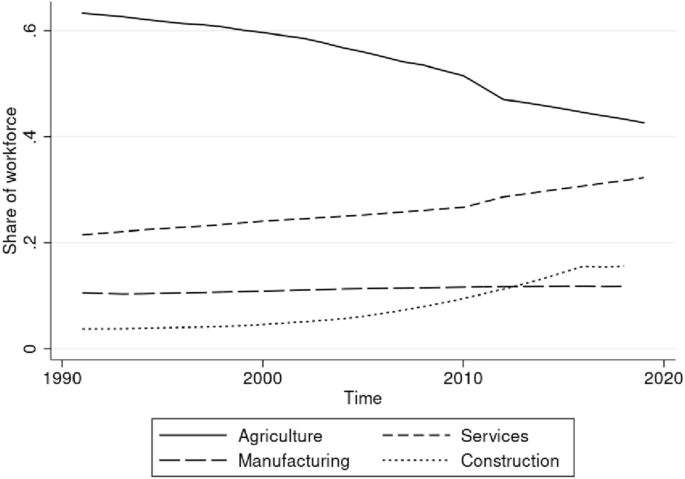
While such time trends are useful in gauging the extent to which the economy is experiencing a structural transformation, the question of whether the pace of change is “high” or “low” remains unanswered. For this, we need some reference points. I now turn to a cross-country analysis that can allow us to answer this question.
A central theme in this paper is that we need clear benchmarks or indicators to discuss the success or failure of growth in delivering structural change. These indicators (such as those discussed in Sect. 2) should place employment (not output) at the centre of the structural change story. How does India’s performance on these indicators compare with other developing countries? In this section I use the World Development Indicators as well as the Groningen Economic Transformation Database to address this question.
It is well known that the relationship between GDP growth and employment generation has been weakening over time in India. However, it is also true that many developing economies are facing the same headwinds of automation and premature deindustrialisation, resulting in poor job creation. Hence, it is useful to get a sense of how much better or worse than average has India’s performance been.
Table 4 shows initial levels of GDP per capita as well as the growth elasticity of employment for three periods—1990 to 2000, 2000 to 2010 and 2010 to 2018. Footnote 7 In the 1990s, India’s elasticity at 0.38 was the highest among the small subset of countries shown, but in the overall distribution of all developing countries, it was below median (it fell in the second quartile). During the 2000s, it fell to 0.26 which was in the bottom decile. In the 2010s, at 0.11 it was once again in the bottom decile. This result is robust to excluding countries that display unexpectedly low (negative) or high (above 2) values of employment elasticity. Thus it seems clear that India was a below median performer in employment generation over the entire period since the 1990s. Moreover, even in relative terms, India slide down the elasticity distribution, indicating a worsening performance over time.
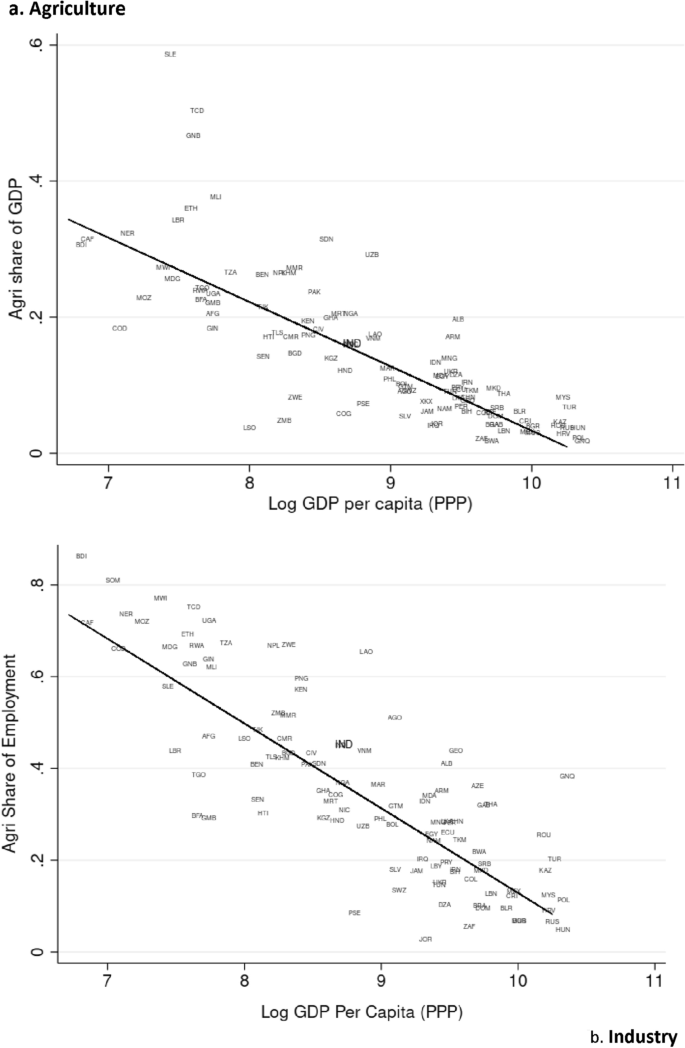
The story is different when one looks at employment shares. Figure 3 shows that India lies above the regression line for agricultural share of employment, indicating that the proportion of the workforce in agriculture (43%) is around 8.8% points higher than expected from the average relationship across all the countries in the dataset. However, this is a relatively small deviation, as seen in the fact that India lies close to the bottom of the 4th quartile in the residuals distribution, rather than in the top two or three deciles. What might perhaps come as a surprise is that India lies above the regression line in industry share of employment and below it in services share. India’s industrial share of employment is 6.4% points higher than predicted, while its services share is 15% points lower than predicted for its level of GDP per capita. For services, India is in the bottom decile of the residuals distribution. Footnote 10
The answer to the apparent puzzle lies in the performance of the construction sector. Figure 4 shows similar plots as before (but only for employment shares) for the two main components of the industrial sector, viz. manufacturing and construction. The data are noisier and only available for half the number of countries. Footnote 11 But clearly (and perhaps surprisingly), for manufacturing India lies close to the regression line (residual of only 0.9% points). While for construction, India is a large outlier with its employment share being 9% points higher than predicted, lying in the top 1% of the residuals distribution.
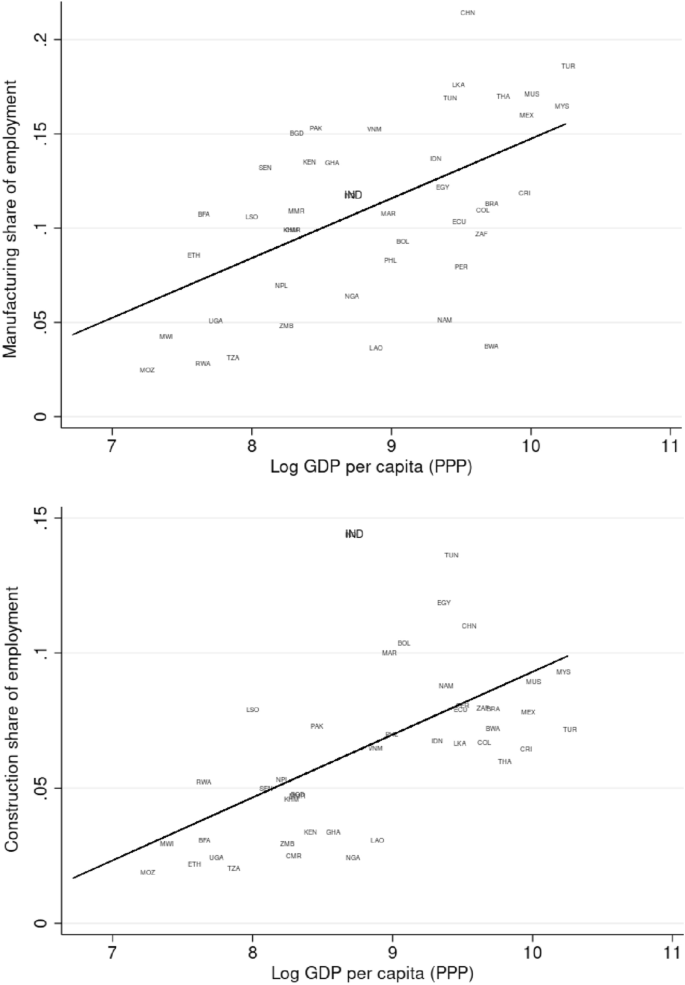
The above analysis broadly confirms well-known stylized facts regarding the Kuznets process for India but also throws up a few surprises. Narrowly defined as movement of workers out of agriculture to the non-farm sector, the process is taking place more or less as expected. It is true that given its level of GDP per capita, India has a higher share of workers in agriculture, but not extraordinarily so. More importantly, instead of moving into higher value-added sectors such as manufacturing or modern services, the bulk of the transition has been into low value-added construction activities (Nayyar 2019a; b). India is indeed a strong outlier when it comes to the share of the workforce engaged in construction.
Now, we move from the Kuznets Process to the Lewis Process. Here, data are much more scarce. Reliable and comparable cross-country measures of the size of the informal sector are difficult to come by. The WDI database gives only one indicator, viz. the share of self-employment in total employment. However, the ILO database from which this indicator is drawn, has some definitional problems and inconsistencies. Footnote 12 It seems safe to assume that this indicator in fact gives the share of the workforce engaged in both self-employment and casual wage work. Hence I refer to it as the share of informal employment in total employment. Figure 5 gives the by now familiar scatter plot for informal share versus GDP per capita. At 76.5%, India is an outlier, having a much higher informal sector share of employment for its level of GDP per capita. In the residuals distribution, India lies in the top 5% with its share being 23% points higher than predicted.

To summarise, it is well known that India’s structural transformation has been slow in pace and unusual in nature. The above analysis allows us to say in what ways it is slow or unusual. First, with respect to GDP shares, the Indian economy is not very unusual, lying mostly close to the regression line for all three sectors. Somewhat more unexpectedly, India is not much of an outlier on the high side with respect to agricultural share of employment either. Neither is it an outlier with respect to the manufacturing share. Rather, it has far smaller than expected services share and far larger than expected construction share of employment. And most importantly, it has a far higher than expected informal share of employment. Thus the overall picture that emerges is that of an economy in transition away from farm employment to informal employment in construction. While this conclusion is not a surprise, the foregoing exercise tells us approximately how much India conforms to or departs from the norm, for both the Lewis and Kuznets Processes.
One caveat is in order here. The foregoing analysis, by definition, relies on comparison with averages. So global trends that affect most developing countries in a similar way, such as their failure to industrialise, will shape our interpretation of the results. To say that India has the expected share of workers in manufacturing, is only to say that it is being affected in the same negative way as many other countries. The most we can say is that it is no worse a performer than the average country at its level of per capita income.
The foregoing analysis gives us a snapshot in time (in this case 2018) of how the growth process up till that point has related to structural change. However, it is also worth knowing how the relationship has changed over time. For this we can make use of the panel aspect of the WDI/ETD databases. I now present the results of a country fixed effects regression model shown below. Footnote 13
The LHS variable is either share of agriculture in employment or the share of the informal sector in employment. On the RHS, we have the log of GDP per capita (in PPP terms) as well as country dummies (C) and a series of interactions between the country dummies and GDP per capita. The base coefficient on log GDP gives us the semi-elasticity of structural change with respect to GDP for India, in other words, the change in the share of agricultural or informal employment with a 1% change in GDP per capita. The interaction terms can be used to measure the extent to which any particular country differs from India.
Table 5a displays the semi-elasticities for India and a few other countries with comparable GDP per capita in the first year for which data are available (1990). As expected all the numbers are negative, i.e. the share of the workforce engaged in agriculture as well as informal activity decreases with growth. The question that this analysis allows us to answer is how effective was growth in doing so, for India, as compared to other countries. For India, in the period in question (1990 to 2019) a doubling of GDP per capita is associated with a 17% point decline in the share of agricultural employment. The relationship between GDP growth and informal employment is, as expected from the foregoing section, much weaker, at 7% points. The other three countries are much better in terms of a decrease in informal employment.
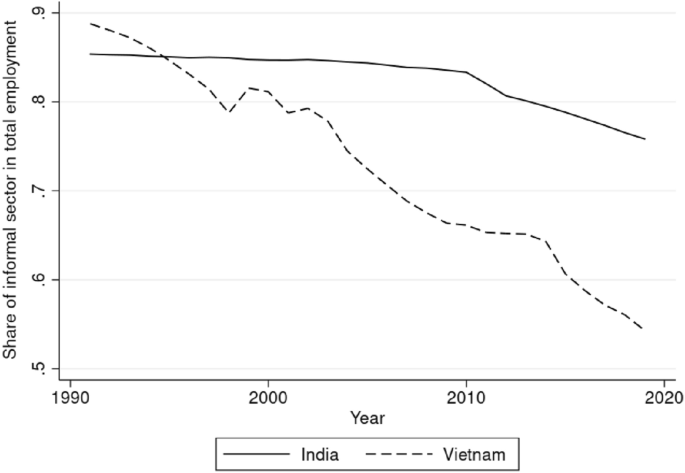
Finally, it is worth noting in Table 5b, that reduction in informal share is generally slower than reduction in agricultural share for all the four countries (exception is Vietnam since the 2000s), but the contrast between the two shares is particularly stark for India, showing again the divergence between the Lewis and Kuznets processes.
We have seen in the foregoing analysis that India’s sectoral structure is an outlier among developing countries in having a higher than expected employment share in construction and a lower than expected share in services. It also has a higher than expected share of the informal sector. Taken together with the declining growth elasticity of employment, this points to a serious long-term obstacle to improving employment conditions for the vast majority of workers. Previous experience of successful structural transformers points to the crucial role of manufacturing in absorbing low educated workers into relatively high productivity occupations. There is an ongoing debate on whether that role can be played by services (especially tradable services like IT-BPO) in the Indian context (Ahsan and Mitra 2016; Amirapu and Subramanian 2015; Gupta and Basole 2020; Ghose 2014).
Without entering into this debate here, I wish to draw attention to a potential vicious cycle or perverse feedback loop that may be holding back India’s structural transformation. This is a loop between declining viability of subsistence production (and in particular of agriculture) and precarious employment in the modern sector, resulting in low earnings and inadequate demand which stimulates only a limited set of economic activities that do not generate productive employment for uneducated workers in the required numbers, perpetuating the reliance on subsistence activity for a livelihood. The chain of causation is summarised in Fig. 7.
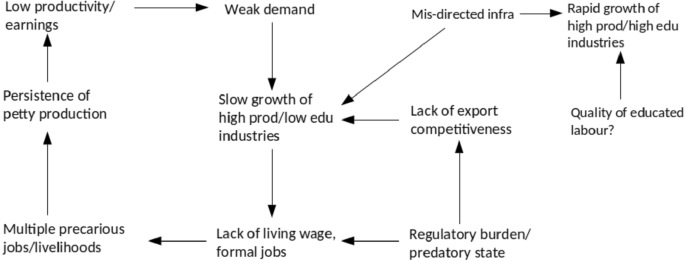
Let us start from the persistence of petty or subsistence production. The vast majority of households are involved in small-scale farm or non-farm production, which is marked by low productivity and incomes resulting in weak broad-based demand. The modern sector therefore relies heavily on demand from a relatively small section of the population, whose high incomes drive demand for relatively more capital (and import) intensive goods and services. Meeting such demand increases the capital intensity of production, leading to slow growth of employment in the modern sector. While inability to meet even basic consumption requirements from petty production forces workers to look for other sources of income, what is available is more informal employment. The result is multiple jobs and precarious livelihoods, that induces peasants to hold on to their small plots of land and other petty producers to cling to fallback sources of livelihood. This completes the vicious cycle. The structure of demand plays a key role here in two ways—first in driving relatively more capital intensive production and second in depressing incomes in the subsistence economy where a proliferation of supply is not met with a proportionate increase in demand (i.e. hyper-competition among petty producers keeps margins and incomes low). The State figures in this story in two main ways. First, in its regulatory role, it becomes predatory, burdening small enterprises and preventing growth, and second it provides infrastructure that largely benefits capital intensive industry (in manufacturing and services) that demands a higher educated workforce. Footnote 14 The foregoing is only an outline of a possible mechanism. Formalising the causal connections remains for future work.
This section is based on Chapter 8 of State of Working India 2021.
A central lesson from the analysis presented here is that economic growth cannot be the focus of economic policy if we desire a structural transformation that improves employment conditions for the vast majority. Rather we need to address employment and structural change as direct policy goals. It is clear from the foregoing and from the wider literature cited in this paper, that India’s employment challenge is multi-dimensional. A systematic approach that addresses both supply-side and demand-side issues in the labour market is needed.
I conclude with an outline of a possible National Employment Policy. Such a policy will need to bring together various supply and demand-side dimensions of the labour market and speak coherently to existing trade and industrial policy regimes. Table 6 (adapted from State of Working India 2021) lays out the framework. A first broad distinction is made between demand-side of the labour market, i.e. policy interventions aimed at raising the demand for labour and improving the quality of work, versus measures on the supply-side that aim to improve the quantity and quality of supply of labour. Under both heads, a further distinction can be made between direct job creation by governments on the one hand and promoting as well as regulating private sector employment on the other hand.
Table 6 A framework for a national employment policyThe dimensions along which interventions can be made are discussed under two heads—quantity of employment and quality of employment. On the quantity aspect, four sub-dimensions are identified—increasing the scale of production, creating employment in labour surplus (migrant-sending) states, improving participation of women in paid work, and promoting labour-intensive sectors. On the quality aspect three sub-dimensions are identified—raising productivity, promoting wage growth, and providing social security. The table also lists key policy interventions under each category. Going into the details of the policy measures is outside the scope of the present paper. The reader is referred to State of Working India (2019) for more on urban employment guarantee (UEG) and universal basic services (UBS), and to Muralidharan et al. (2020) for USENET. Needless to say, these only indicative and not exhaustive policy suggestions.
The analysis presented in this paper shows that the pace of employment generation as well as structural change has been low in India, as compared to other developing countries. But even as the situation worsened in terms of aggregate employment generation, it improved somewhat in terms of a decline of self-employment and casual labour. Of course, a large and diverse economy such as India is likely to have several different narratives of structural change that apply to different states and regions. Hence, the high-level cross-country analysis is only a starting point for more disaggregated analyses.
I have also proposed that the following five indicators need to be kept track of when evaluating the growth process: the growth elasticity of employment, the growth semi-elasticity of structural change, the growth of labour productivity in the subsistence sector, the share of the organised sector in total employment and the workforce participation rate. Comparing these indicators across periods (e.g. pre- or post-reform), states, regions or countries, allows us to understand which sets of policies have worked better than others to effective improvements in employment conditions. And taken together the indicators allow us to set structural change targets as well as to say whether the current pattern of growth is going to be sufficient to meet those targets.
Finally, an initial attempt has been made to lay out a conceptual model to explain slow structural change and to propose a framework for a National Employment Policy. Developing both these further remains for future work.
A large literature has developed around most of the issues mentioned here. For e.g. see Amirapu and Subramanian (2015), Deshpande and Singh (2021), Ghose (2014, 2020), Kannan and Raveendran (2009), Kapoor and Krishnapriya (2017), Lahoti and Swaminathan (2016), Mehrotra (2018, 2019), Nayyar (2019a, b), State of Working India (2018) and Thomas (2012).
Possible exceptions to this rule are economies endowed with oil or other natural resources, and other small countries with special conditions.
See Nayyar (2019a, b) for more on this mutual causation.There is an interesting emerging literature on the nature of India’s structural transformation, on the basis of which some of the above points have been made. See Ahsan and Mitra (2016), Amirapu and Subramanian (2015), Mehrotra and Parida (2021), Ghose (2020) and Nayyar (2019b). The connection between persistent informality and low wages on the one hand, and lack of broad-based demand leading to weak structural transformation has been stated often but not shown empirically, e.g. Roy (2019).
See Ghose (2020) for more details. Note, however, there are a few labour-intensive industries such as leather and footwear, plastics, and garments and knitwear, which did create jobs in the recent period (Basole and Narayan 2020).
Note that there is a discrepancy between the share of informal employment as measured by these definitions from NSSO data and the WDI/ILO numbers (76.5%).
The elasticities are estimated from a panel regression of log employment on log GDP per capita with country fixed effects as well as interactions between country dummies and log GDP per capita. In such a regression, the base coefficient on log GDP gives the employment elasticity for the base country (India). The interaction coefficient for a given country tells us how much greater or lesser elasticity is for that country compared to India.
See Ghose (2014) for another such exercise for India.Here and in all other such regressions I use GDP per capita in PPP terms. However, the results are not qualitatively altered by using exchange rate constant dollars. Countries with GDP per capita (constant 2015 USD) higher than USD 13,000 (i.e. high income countries) or with population less than 1 million are excluded from the analysis.
Ghose (2014) finds the same to have been the case in 2000, 2005, and 2010, noting that India was a significant outlier on the low side in share of services in total employment. But in his analysis the departure is even more stark with a 25 percentage point difference between predicted and actual shares.
Data for manufacturing and construction shares in employment and construction share of output are not available in the WDI database. Employment shares have been obtained from the Groningen ETD. The sample falls from 104 countries in WDI to 43 in ETD.
The regression excludes countries with a population less than 1 million. The quality of this education is a separate concern that arises but that need not concern us here.No funding was received for this study.